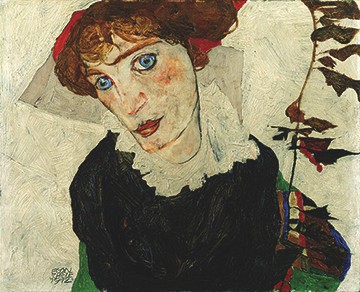The first week of November marked the 32nd annual Holocaust Education Week in Toronto. The week-long schedule of lectures, films, exhibits, and theatre was crammed with multiple events each day throughout the GTA. While Holocaust Education Week is now behind us, it raises some interesting questions about the place of art in Holocaust remembrance.
The theme for the 2012 Holocaust Education Week was “Culture of Memory.” The various programs associated with the event explored how the Holocaust can be preserved and remembered as survivors — and the firsthand testimony that they provide — dwindle steadily with the progression of time.

"Portrait of Wally" by Egon Schiele. PHOTO COURTESY BROWN & COHEN COMMUNICATIONS & PUBLIC AFFAIRS INC.
Contemporary recollections of the Holocaust are largely informed by parties who claim a secondhand legacy as their own. The history of the Holocaust is markedly well-documented and well-known, and is itself a thriving field of academia. But the memory of the Holocaust is far more ambiguous, attempting to access emotions and experiences which are quite conceivably unfathomable to anyone but actual witnesses.
Collective memory of the Holocaust is often formed and transmitted through artistic representation. Authors, artists, and filmmakers find an apt forum to explore the experience of the Holocaust in the realm of art. The production of these works is itself a source of debate; many people seek connection and understanding through artistic portrayals of the genocide, but critics suggest that such productions run the risk of minimizing or distorting the scope of the tragedy.
The struggle to properly express tragedy through artistic representation is continually linked to the responsibility to provide a warning against the potential for the repetition of history, a sentiment summarized by the oft-quoted dictum “never again.” The reasons for rendering the Holocaust in art are manifold, including the complex desire to connect to a grievous past.
The Centre for Jewish Studies at U of T recently hosted a panel titled “Anne Frank in the Contemporary Imagination” that featured prominent Jewish author Nathan Englander (whose most recent collection of short stories is titled What We Talk About When We Talk About Anne Frank), Karen Polak, head of education at The Anne Frank House in Amsterdam, and Andrea Most, associate professor of American Literature and Jewish Studies at U of T.
The topic of their discussion is current and controversial, particularly when it comes to literature that deals with the Holocaust. While the diary of Anne Frank was once endowed with a sacred, untouchable quality, Most noted that it has since become the subject of significant controversy. A Broadway play about Anne Frank has been criticized for presenting a diluted, accessible version of the Holocaust and removing distinctly Jewish aspects from the narrative in order to produce a more universal coming-of-age story.
Many prominent American-Jewish authors have also questioned the place of Anne Frank in contemporary society. In Philip Roth’s novel The Ghost Writer, the main character imagines that he is in a relationship with Anne Frank, who has actually survived the Holocaust but hidden her identity so as not to disturb the symbolism acquired by her name. Cynthia Ozick, in an article that ran in the New Yorker, has suggested that the memory of the Holocaust would have been better served had the diary not been disseminated.
Englander, for his part, was proud to declare during the panel that in spite of the title of his latest book, he has not actually read the diary of Anne Frank. Instead, he based his fiction upon his own anxiety about the possibility of a second Holocaust, an anxiety that stems from his childhood. His stories are nuanced, reflecting upon the memory of the Holocaust and the cultural inheritance of suspicion and guilt.
The issue of Holocaust remembrance has also been explored by a multitude of visual artists. During Holocaust Education Week, the AGO displayed “Memory Loops,” an audio-based installation by artist Michaela Melián. The installation features the spoken testimony of Holocaust survivors, allowing Melián to reflect upon history through the medium of art. She provides viewers with an access point to primary sources through the secondary lens of her artistic point of view.
The Holocaust has, of course, also acted as the backdrop for a plethora of films, from Schindler’s List to Inglorious Basterds. More specifically related to art was the documentary Portrait of Wally, which was recently screened at the TIFF Bell Lightbox as part of Holocaust Education Week. The film details the history of a painting by Egon Schiele and the legal battle that erupted between the Leopold Museum in Vienna and the Jewish family who owned the painting prior to its seizure by Nazis in 1939. The case brought to the fore the issue of Nazi art looting, prompting museums across Europe and America to purge stolen property from their collections.
While contending with the Holocaust requires artists to tread on delicate territory, artistic attempts to articulate the emotional experience of the Holocaust contribute to the construction of collective memory of this dark period in human history. As the shadow of the Holocaust draws further into the past, art preserves and constructs the tragedy of the Holocaust with heightening urgency and innovative perspective.

